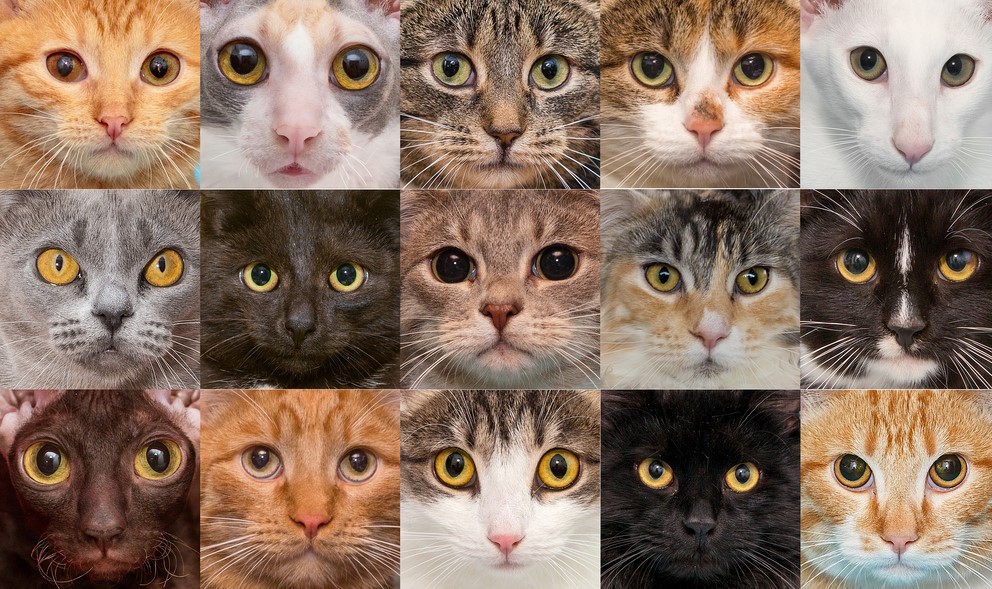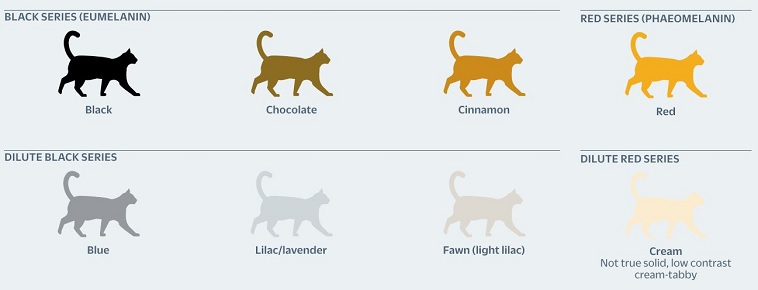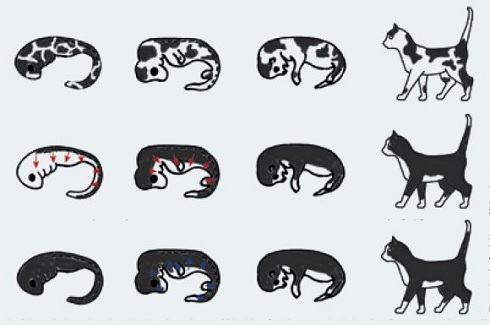How the cat got its stripes

Ever wondered why your cat looks the way it does? Dr Jill Johnson explores how various genes combine to make moggies from ginger to blue, striped or blotched, wearing tuxedos or socks, and even, occasionally, with six toes
May 27th 2022
In the UK about 26% of adults have a cat and Britain has an estimated population of over 10 million pet cats. Our beloved moggies (Felis catus) are the only domesticated species of the family Felidae, which includes everything from the big cats (lions, leopards, tigers and jaguars in the genus Panthera) to medium-sized (caravals, ocelots, lynx and puma) and small cats such as Felis silvestris, the wildcat from which the domestic cat is descended.
Recent studies have shown that the Near Eastern and Egyptian populations of Felis silvestris lybica have both contributed to the gene pool of the domestic cat throughout different periods of history, most notably around the time of the first farmers in the Neolithic period. Wildcats became commensal with humans in the Middle East around 10,000 years ago, with the farmers’ grain stores drawing in plenty of the cats’ favoured rodent prey.
After these early interactions with humans, cat dispersal really took off during the classical period, when the Egyptian cat spread throughout the Old World and became a true member of the family. There is evidence that domestic cats accompanied humans on their trade routes; the Vikings and the Romans were particularly good at taking cats along on their conquests. It has even been said that for a time Viking longships were forbidden to sail without a cat on board to deal with rodent pests.
For many thousands of years most domesticated cats looked very much like their wildcat ancestors, with a coat of varying shades of brown patterned with narrow vertical stripes. Coat colour variants appeared only after the Middle Ages, suggesting that the directed breeding of cats occurred later than with most other domesticated animals.
It wasn’t until the late 1800s that the ‘cat fancy’ came to be, when Englishman Harrison Weir carried out the first pedigree cat show and published the book Our Cats and All About Them: Their Varieties, Habits and Management. The guide established the standards for the common breeds of the time. Since then, based on genetic data from more than 1,000 cats, at least 17 random-bred populations of domestic cats have been identified, constituting 22 breeds. Over 70 genetic variants have been defined and about 40 of these affect the appearance of the cat – that is, coat colour, coat pattern, coat length, eye colour and body structure.
Cats and colour
Like humans, the domestic cat and its closest wildcat ancestor are diploid (with two copies of each chromosome) and cats possess 38 chromosomes arranged as 18 somatic pairs + the X and Y sex chromosomes. The cat genome contains roughly 20,000 genes (similar to the human genome) and has been investigated in fairly good detail. Gene expression on the somatic (non-sex) chromosomes usually occurs in dominant/recessive patterns, but extra layers of complexity can modify this, such as polygenic traits (regulated by more than one gene), incomplete penetrance, epigenetics and environmental cues.
One of the most obvious examples of dominant and recessive genetic variants is black fur. The black hair colour – which is actually a very dark brown – is generated by the protein eumelanin, the expression of which is encoded by the Brown gene. The gene produces tyrosinase-related protein 1 (TYRP1), an enzyme involved in the metabolic pathway for eumelanin pigment production. The dominant form, B, produces black eumelanin; the two recessive variants, b (chocolate) and bl (cinnamon), result in a much lighter-coloured cat.
In cats with orange fur the red pigment phaeomelanin completely replaces the black-brown eumelanin. The gene for this, Orange, is located on the X chromosome, meaning both variants of the gene can be expressed in females. Males, having just the one X chromosome, can typically only be orange or non-orange, but females can be orange, black or brown, or tortoiseshell, with patches of orange and black. With two X chromosomes, which chromosome is active in each cell is purely chance – hence the seemingly random distribution of orange and black in tortoiseshell cats.
Gene interactions are also very important in determining cat coat colour. The recessive form of the Dilution gene, d, encodes for the eumelanin regulator melanophilin, which effectively dilutes coat colour, turning a black coat ‘blue’ (appearing grey). Chocolate becomes ‘lilac’ (appearing light brown), cinnamon becomes ‘fawn’ and ginger becomes ‘cream’.
Tabby cats are in fact striped twice, with a pattern of stripes on the body plus stripes (or bands) on individual hairs. To control the former, the Tabby gene encodes for a protein called transmembrane aminopeptidase Q (Taqpep), a membrane-bound metalloprotease that controls skin thickness and thus pigment concentration. The dominant allele, TM, produces mackerel tabbies with tiger-like narrow stripes, while the recessive tb produces blotched tabbies, with the narrow stripes expanding into more expansive whorls.
 Above: The strength of black pigmentation causes varieties of black and brown cats, which can be further modified by a diluting gene. In cats with orange fur, the red pigment phaeomelanin completely replaces the black-brown eumelanin and can also be ‘diluted’ to a cream colour. Further diluting genes can result in caramel and apricot coloured-cats (not shown).
Above: The strength of black pigmentation causes varieties of black and brown cats, which can be further modified by a diluting gene. In cats with orange fur, the red pigment phaeomelanin completely replaces the black-brown eumelanin and can also be ‘diluted’ to a cream colour. Further diluting genes can result in caramel and apricot coloured-cats (not shown).Splitting hairs
Individual tabby coat hairs also have stripes on them, regulated by the Agouti gene A/a. The dark stripes of the overall body pattern (whether mackerel or blotched) have an even distribution of pigment, while the rest of the coat is made up of banded hairs, with dark melanin-rich bands alternating with lighter bands. These banded hairs are known as the ‘agouti shift’ phenomenon and can also be seen in dogs, rabbits and rodents, and their contrast with the areas of solid colour create the overall tabby effect.
The wild-type A produces the agouti shift phenomenon, while the recessive a allele leads to a solid-colour coat. A black cat, for example, has the dominant B allele of the Brown gene as described above, but is recessive for Agouti (a), so individual hairs do not have alternating light and dark bands of colour, and its stripes can’t be seen.
Interestingly, in some solid-colour cats the appearance of the Tabby gene isn’t completely repressed by the recessive a allele of Agouti. This means that faint tabby stripes can still be seen, commonly on the legs and tail or the classic ‘M’ pattern on the head. However, these are very difficult to see – the best chance to catch them is in bright sunlight or when these cats are young kittens.
Now add white
Epistasis occurs when the expression of one gene is affected by the expression of one or more independently inherited genes. One example is how white coat colour is regulated: white fur in cats is epistatic over all other coat colours. There are two genes responsible for white fur: White W/w and Spotting S/s. Epistatic White produces a fully white cat with no melanin production at all, and is linked to blue eyes and deafness. In contrast, the more variable white pattern of Spotting can take many forms, from a small spot of white, to ‘tuxedo’ patterns, to the mostly white pattern of the Turkish Van cat.
The spotted white regions are likely areas where melanin-producing cells known as melanocytes have failed to migrate or have died off. Melanoblasts, the precurser cells of melanocytes, derive from the neural crest during embryonic development and migrate along the dorsolateral axis, which explains coat colour patterns that are dark on the back and white around the belly, the snout and the paws. However, recent research has suggested there may be a second source of nerve-derived melanoblasts, which could explain white patches across the body (see ‘Theories of how white spotting works’.
 Above: Three theories have been proposed to explain why white spotting appears in particular places on cats. Top: melanoblasts migrate evenly across the skin surface but the expanding surface then ‘cracks’, breaking up the surface into islands of colour. Middle: The melanoblasts migrate from the neural crest but don’t reach the furthest area – i.e. the paws, face and belly. Bottom: Melanoblasts migrate evenly across the skin surface, but an opposing cellular mechanism, spreading out in the opposite direction, causes them to die off.
Above: Three theories have been proposed to explain why white spotting appears in particular places on cats. Top: melanoblasts migrate evenly across the skin surface but the expanding surface then ‘cracks’, breaking up the surface into islands of colour. Middle: The melanoblasts migrate from the neural crest but don’t reach the furthest area – i.e. the paws, face and belly. Bottom: Melanoblasts migrate evenly across the skin surface, but an opposing cellular mechanism, spreading out in the opposite direction, causes them to die off.
The expression of the genes and proteins that regulate cat coat colour can also be controlled by environmental factors such as temperature, where pigment protein is only expressed in the cooler regions of the body. So-called colourpoint cats have dark colours on the face, ears, feet and tail, with a lighter version of the same colour on the rest of the body, and possibly some white.
This pigment pattern is the result of a temperature- sensitive mutation in tyrosinase, the enzyme that converts tyrosine into the different types of melanin.
Finally, cat fur length is governed by the Length gene – the dominant form L codes for short hair and the recessive version l codes for long hair. In long-haired cats, the transition from the anagen (hair growth) to catagen (cessation of hair growth) phase of hair growth is delayed due to this mutation.
To date, the genetics of feline eye colour have not been heavily studied apart from blue eyes, which are unusual in cats. Eye colour is complex and mediated by multiple genes, and odd eyes are most common in epistatic white cats where one eye is blue and the other is orange, yellow, brown or green. Polydactyl cats, with more than the usual number of toes on one or more paw, is a result of the gene Polydactyla, which encodes for the protein Sonic hedgehog (SHH), which has key roles in cell growth, cell specialisation and the normal shaping (patterning) of the body. Recent work has shown that the defect is generally the same in cats as in humans. The extra digits can vary in number and also in structure, often looking like a thumb.
The genetic mechanisms regulating the myriad colour patterns of cats are defining characteristics of the entire Felidae family. These colour patterns are established during embryonic development and controlled by a number of both genetic and environmental factors. Further insights into our molecular understanding of how cats got their stripes, and other aspects of their appearance, will contribute to determining the critical genetic mechanisms regulating pattern variation in other mammals.
The famous mathematician Alan Turing worked for years on a set of mathematical equations to explain how signalling molecules might help cells create patterns across the skin or fur of animals, in the hope of gaining a better understanding of morphogenesis and development. He said of the zebra: “Well, the stripes are easy. But what about the horse part?”
1. The Bengal cat was created as a hybrid of domestic cats, including the spotted Egyptian Mau and the Asian leopard cat (Prionailurus bengalensis), giving Bengals their wild appearance and spots, rosettes, arrowhead markings or marbling.
2. The ragdoll is a large cat breed with a silky-soft colourpoint coat and blue eyes, developed by American breeder Ann Baker in California in the 1960s. A regular, non-pedigreed, white domestic long-haired cat named Josephine produced several litters of typical cats, but then produced kittens with a docile, placid temperament, affectionate nature and a tendency to go limp and relaxed when picked up – like ragdolls.
3. The sphynx is a breed of cat developed in Toronto and known for its lack of fur – its hairlessness is mediated by the naturally occurring genetic mutation Hairless Hr/hr. The mutation also affects their whiskers, and the cats have a narrow, long head and webbed feet.
4. The Manx cat originated on the Isle of Man, with a naturally occurring mutation that shortens the tail (Tailless (Manx) M/m). The tailless mutation can lead to serious health problems such as lameness, incontinence and constipation, known as Manx syndrome.
5. The Scottish Fold has a natural dominant gene mutation that affects cartilage throughout the body, causing the ears to fold forwards and down. The original Scottish Fold was a white barn cat named Susie, who was found at a farm near Coupar Angus in Perthshire, Scotland, in 1961. These cats are susceptible to polycystic kidney disease, cardiomyopathy and osteochondrodysplasia.
6. The Persian cat is a long-haired breed with a round face and short muzzle. The first ancestors of Persian cats were imported into Italy from Persia in the 17th century. Selective breeding has led to the development of a wide variety of coat colours, as well as increasingly flat-faced Persians, which leads to a number of health problems.


